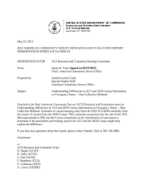
An official website of the United States government
Here’s how you know
Official websites use .gov
A .gov website belongs to an official government organization in the United States.
Secure .gov websites use HTTPS
A lock (
) or https:// means you’ve safely connected to the .gov website. Share sensitive information only on official, secure websites.
-
//
- Census.gov /
- Library /
- Census Working Papers /
- ACS and 2010 Census Occupancy Status - Data Collection Methods
Understanding Differences in ACS and 2010 Census Information on Occupancy Status - Data Collection Methods
Understanding Differences in ACS and 2010 Census Information on Occupancy Status - Data Collection Methods
A major goal of both the American Community Survey (ACS) and the Census is to determine the unit status for every address in their operation. This means classifying every sample address as valid or invalid and for all valid units determining if the unit is occupied or vacant. It is reasonable to expect that both the ACS and the 2010 Census would define the status of a housing unit the same. However, recently released 2010 ACS estimates of vacant housing units differ markedly from the counts of vacants from the 2010 Census. While the majority of sample units are relatively easy to classify, both operations face situations where classification is more difficult and it is possible that there are subtle differences in the way that the two handle these types of situations. Since most vacant units obtain their unit status during a personal interview, we wanted to research into the role of the field representative (FR) and the census enumerator in the classification of unit status. There were two main purposes for this research. One was to review the procedures and training materials used by FRs in the ACS and enumerators in the 2010 Census and identify any differences that could contribute to discrepancies in how they classify addresses. The second was to conduct debriefing sessions with ACS FRs in an attempt to gain insight into how they interpret the procedures and materials provided, as well as learn the challenges that they face when classifying housing units.
Others in Series
Working Paper
Working Paper
Working Paper
Share
Some content on this site is available in several different electronic formats. Some of the files may require a plug-in or additional software to view.
 Yes
Yes
 No
NoComments or suggestions?


Top

